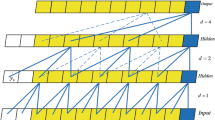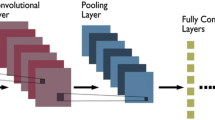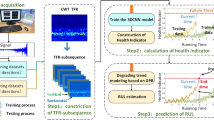Abstract
It is essential for the remaining useful life (RUL) prediction of bearings to ensure the safe operation of rotating machinery. Rotating machines are highly complex. However, the critical degradation information of bearings is often neglected due to the insufficient perceptual field of temporal convolutional networks, which results in poor prediction results. To solve the problems, a new framework named temporal convolutional network with residual separable convolutional block (TCN-RSCB) is proposed in this paper for bearing RUL prediction. First, RSCB is constructed by using residual learning and separable convolution. In RSCB, in order to obtain a larger perceptual field, we continuously increase the dilation factor of the separable convolution according to the exponential level. Then, a soft thresholding temporal convolution block (STCB) is constructed by using a soft thresholding technique, this block can eliminate the redundant information in the prediction network and improve the prediction results of bearing RUL. Finally, the proposed method is tested on the FEMTO-ST dataset and the XITU-SY dataset, and compared with some advanced prediction methods. The results indicate that TCN-RSCB can follow the real RUL well on different bearing datasets, and has good robustness and generalization ability.











Similar content being viewed by others
References
Zhao Z, Liang B, Wang X, Lu W (2017) Remaining useful life prediction of aircraft engine based on degradation pattern learning. Reliab Eng Syst Saf 164:74–83
Ma M, Mao Z (2021) Deep wavelet sequence-based gated recurrent units for the prognosis of rotating machinery. Struct Health Monit 20(4):1794–1804
Glowacz A et al (2019) Detection of deterioration of three-phase induction motor using vibration signals. Meas Sci Rev 19(6):241–249
Shi H, Bai X (2020) Model-based uneven loading condition monitoring of full ceramic ball bearings in starved lubrication. Mech Syst Signal Process 139:106583
Londhe ND, Arakere NK, Subhash G (2018) Extended hertz theory of contact mechanics for case-hardened steels with implications for bearing fatigue life. J Tribol 140(2).
Fink O, Zio E, Weidmann U (2015) A classification framework for predicting components’ remaining useful life based on discrete-event diagnostic data. IEEE Trans Reliab 64(3):1049–1056
An D, Xu B, Li S, Shao M, Xu Y, Zhang L (2021) Predicting residual life of rolling bearing using IMMFE and BiLSTM-GRU-LR. J Braz Soc Mech Sci Eng 43(8):1–18
Qin Y, Xiang S, Chai Y, Chen H (2019) Macroscopic–microscopic attention in LSTM networks based on fusion features for gear remaining life prediction. IEEE Trans Industr Electron 67(12):10865–10875
Yin J, Xu M, Zheng H, Yang Y (2020) A new Wasserstein distance-and cumulative sum-dependent health indicator and its application in prediction of remaining useful life of bearing. J Braz Soc Mech Sci Eng 42(9):1–15
Fei S-W (2015) Kurtosis forecasting of bearing vibration signal based on the hybrid model of empirical mode decomposition and RVM with artificial bee colony algorithm. Expert Syst Appl 42(11):5011–5018
Ding P, Jia M, Wang H (2021) A dynamic structure-adaptive symbolic approach for slewing bearings’ life prediction under variable working conditions. Struct Health Monit 20(1):273–302
Ding P, Jia M, Yan X (2021) Stationary subspaces-vector autoregressive with exogenous terms methodology for degradation trend estimation of rolling and slewing bearings. Mech Syst Signal Process 150:107293
Ren L, Sun Y, Cui J, Zhang L (2018) Bearing remaining useful life prediction based on deep autoencoder and deep neural networks. J Manuf Syst 48:71–77
He Z, Shao H, Ding Z, Jiang H, Cheng J (2021) Modified deep autoencoder driven by multisource parameters for fault transfer prognosis of aeroengine. IEEE Trans Industr Electron 69(1):845–855
Li X, Zhang W, Ma H, Luo Z, Li X (2021) Degradation alignment in remaining useful life prediction using deep cycle-consistent learning. IEEE Trans Neural Netw Learn Syst.
Li H, Zhao W, Zhang Y, Zio E (2020) Remaining useful life prediction using multi-scale deep convolutional neural network. Appl Soft Comput 89:106113
Li X, Ding Q, Sun J-Q (2018) Remaining useful life estimation in prognostics using deep convolution neural networks. Reliab Eng Syst Saf 172:1–11
Yuan M, Wu Y, Lin L (2016) Fault diagnosis and remaining useful life estimation of aero engine using LSTM neural network. In: 2016 IEEE international conference on aircraft utility systems (AUS), 2016, pp. 135–140. IEEE, New York
Chen J, Jing H, Chang Y, Liu Q (2019) Gated recurrent unit based recurrent neural network for remaining useful life prediction of nonlinear deterioration process. Reliab Eng Syst Saf 185:372–382
Qin Y, Chen D, Xiang S, Zhu C (2020) Gated dual attention unit neural networks for remaining useful life prediction of rolling bearings. IEEE Trans Industr Inf 17(9):6438–6447
Nauta M, Bucur D, Seifert C (2019) Causal discovery with attention-based convolutional neural networks. Mach Learn Knowl Extraction 1(1):312–340
Rethage D, Pons J, Serra X (2018) A wavenet for speech denoising. In: 2018 IEEE International Conference on Acoustics, Speech and Signal Processing (ICASSP), 2018, pp. 5069–5073: IEEE, New York.
Bai S, Kolter JZ, Koltun V (2018) An empirical evaluation of generic convolutional and recurrent networks for sequence modeling. arXiv preprint arXiv:1803.01271.
Wang B, Lei Y, Li N, Yan T (2019) Deep separable convolutional network for remaining useful life prediction of machinery. Mech Syst Signal Process 134:106330
Zhang R, Zhu F, Liu J, Liu G (2019) Depth-wise separable convolutions and multi-level pooling for an efficient spatial CNN-based steganalysis. IEEE Trans Inf Forensics Secur 15:1138–1150
Yu F, Koltun V (2015) Multi-scale context aggregation by dilated convolutions. arXiv preprint arXiv:1511.07122.
Guirguis K, Schorn C, Guntoro A, Abdulatif S, Yang B (2021) Seld-Tcn: sound event localization & detection via temporal convolutional networks. In: 2020 28th European Signal Processing Conference (EUSIPCO), 2021, pp. 16–20. IEEE, New York.
He K, Zhang X, Ren S, Sun J (2016) Identity mappings in deep residual networks. In: European conference on computer vision, 2016, pp. 630–645: Springer, Cham.
He K, Zhang X, Ren S, Sun J (2016) Deep residual learning for image recognition. In: Proceedings of the IEEE conference on computer vision and pattern recognition, 2016, pp. 770–778.
Chen D, Qin Y, Wang Y, Zhou J (2021) Health indicator construction by quadratic function-based deep convolutional auto-encoder and its application into bearing RUL prediction. ISA Trans 114:44–56
Wang Y, Deng L, Zheng L, Gao RX (2021) Temporal convolutional network with soft thresholding and attention mechanism for machinery prognostics. J Manuf Syst 60:512–526
Nectoux P et al (2012) An experimental platform for bearings accelerated degradation tests. In: Proceedings of the IEEE International Conference on Prognostics and Health Management IEEE, Beijing, China, 2012, pp. 23–25.
Li X, Zhang W, Ma H, Luo Z, Li X (2020) Data alignments in machinery remaining useful life prediction using deep adversarial neural networks. Knowl-Based Syst 197:105843
Cao Y, Ding Y, Jia M, Tian R (2021) A novel temporal convolutional network with residual self-attention mechanism for remaining useful life prediction of rolling bearings. Reliab Eng Syst Saf 215:107813
Wang B, Lei Y, Li N, Li N (2018) A hybrid prognostics approach for estimating remaining useful life of rolling element bearings. IEEE Trans Reliab 69(1):401–412
Acknowledgements
This research is supported by the National Natural Science Foundation of China (No.62263021), the Science and Technology Project of Gansu Province (Grant No.21YF5GA072), the National Key Research and Development Plan of China (Grant No.2020YFB1713600), the Industrial Support Project of Education Department of Gansu Province (Grant No.2021CYZC-02). The authors would like to thank the referees and an editor for providing useful comments.
Author information
Authors and Affiliations
Corresponding author
Ethics declarations
Conflict of interest
The authors declared that there is no conflict of interest in this work.
Additional information
Technical Editor Jarir Mahfoud.
Publisher's Note
Springer Nature remains neutral with regard to jurisdictional claims in published maps and institutional affiliations.
Rights and permissions
Springer Nature or its licensor holds exclusive rights to this article under a publishing agreement with the author(s) or other rightsholder(s); author self-archiving of the accepted manuscript version of this article is solely governed by the terms of such publishing agreement and applicable law.
About this article
Cite this article
Zhang, Y., Zhao, X. Remaining useful life prediction of bearings based on temporal convolutional networks with residual separable blocks. J Braz. Soc. Mech. Sci. Eng. 44, 527 (2022). https://doi.org/10.1007/s40430-022-03856-6
Received:
Accepted:
Published:
DOI: https://doi.org/10.1007/s40430-022-03856-6




